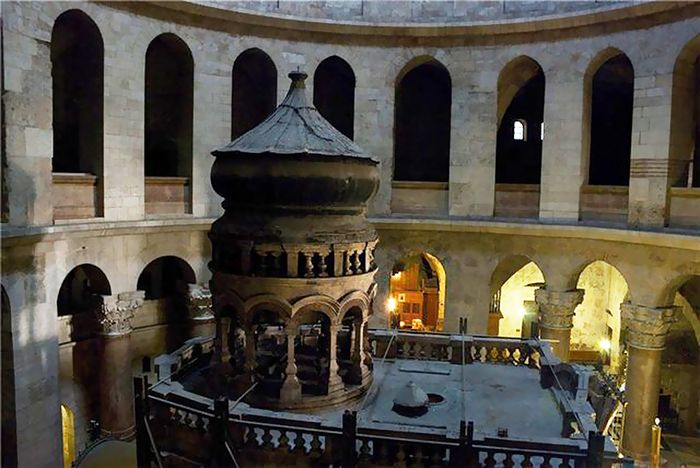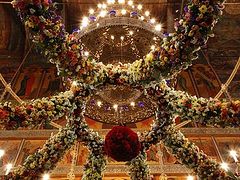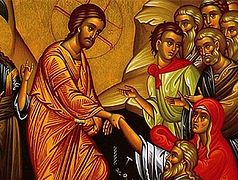In the Ancient Church, the feast of Theophany, also known as the Baptism of Christ, celebrated both the birth of Jesus Christ and His baptism in the waters of the River Jordan.[1] Therefore, Christmas and Theophany were celebrated on the same day. People began to celebrate these feasts separately only in the late fourth century. In Jerusalem, the process of separation of these feasts was slow. This is confirmed by the testimony of Cosmas Indicopleustes written in the fourth century: “The people of Jerusalem celebrate Theophany at Christmas”.[2] Silvia of Aquitaine wrote, “It was the tenth year when people of Jerusalem celebrated Christmas after Theophany on January 6.” St. Silvia’s manuscript also specifies that the celebration lasted eight days, just like the celebrations of Pascha and Pentecost.[3] At night, the celebratory liturgy in the Grotto of Nativity in Bethlehem would be performed by the Bishop of Jerusalem as the Bishop of Bethlehem would be appointed much later.[4] The feast was concurrently celebrated in other locations: during the first three days it was celebrated on Golgotha, on the fourth day, on the Mount of Olives, on the fifth day, in Bethany, on the sixth day, on Mount Zion, on the seventh day, in the Church of the Resurrection and on the eighth day, in the Monastery of the Cross. A great number of pilgrims from Jerusalem and surrounding areas would come to the city to celebrate this eight-day feast. During that time, the monks of Bethlehem would be praying continuously in the Bethlehem church and performing special services in the Grotto of Nativity.[5]
On February 14, people of Jerusalem would celebrate the Meeting of the Lord, which initially was a local feast only. It was established as a church-wide feast in late fifth century, first in the West and later, in early sixth century, in the East.[6] During this feast, the presbyters and the bishop would read the Gospel of the day in the Church of the Resurrection and perform the Divine Liturgy, similar to the celebratory liturgies of the Holy Pascha.
***
Pascha was the greatest of all feasts. It was preceded by the Great Lent that people of Jerusalem observed for eight weeks. Fasting was prohibited on Saturdays and Sundays, except for on Holy Saturday, so every week the fasting was interrupted.[7] Usually those who fasted ate only once a day, but there were exceptions. Some people observed exceptionally strict lent by eating once every two or three days, while some ate only twice a week. These people ate on Saturdays after receiving the Holy Gifts and on Sundays. According to St. Silvia, those who observed an exceptionally strict lent were not praised, just like those who fasted less were not criticized, since observance of lent was believed to depend on the spiritual and moral state of each person. The services of the Great Lent would be performed in the following order: the usual service would be performed after the Midnight Office and Matins on Sundays, followed by the Liturgy performed on Golgotha rather than in the Church of the Resurrection. The Third Hour service would be added to the daily cycle of services (in addition to the Sixth and the Ninth Hour services). Twice a week, the Ninth Hour service (at 3 pm) would be performed on Mt. Zion. This service was performed there not only during Great Lent, but throughout the year, with the exception of times when a feast day of a martyr was celebrated on Wednesday or Friday. During Great Lent, the priests and the bishop would read the Gospel on Mt. Zion. When the Ninth Hour service was over, the bishop accompanied by the singing people would go to the Church of the Resurrection where the evening service would be held. Once a week, usually on Fridays, the all-night vigil would be held after this service, and the Liturgy would be performed on Saturday morning so that the people who ate twice a day could receive Holy Communion.
On Friday of the seventh week of the Great Lent, the all-night service would be held on Mt. Zion and the Liturgy would be celebrated on Saturday morning. After the service, the archdeacon would tell the people to prepare to go to Bethany for the Seventh Hour service (at 1 pm). By that time, the monks would gather in the Bethany cathedral built on the location where Lazarus’s sister met Jesus. They would be waiting there to greet the bishop arriving with the procession. The psalm would be sung antiphonally and the corresponding passage from the Gospel would be read. Following that, the chantors would head toward the Tomb of Lazarus. The surrounding hills would be covered by a great number of people. After the service, one of the priests, standing on a higher ground, would read the Gospel about Jesus eating the Passover with his disciples, and after that everyone would return to the Church of the Resurrection where a regular evening service would be held. On the next day after the Liturgy (i.e. on Sunday – Translator’s note), the archdeacon would announce in the Church of the Resurrection that during Passion Week the Ninth Hour services would be held every day in the Martyrium and that around the Seventh Hour (1 pm) the people would go to the Mount of Olives. At the announced hour, the bishop would visit the church on the Mount of Olives, chants and antiphons would be sung and corresponding verses from the Gospel would be read. After that, everyone would go to Emvomion and after singing and reading prayers there around the Eleventh Hour (5 pm), the Gospel about the triumphant entry of Jesus into Jerusalem would be read.
The amazing procession, attracting a greater number of people on its way, would descent from the Mount of Olives into Jerusalem. People at the front would be carrying palm branches. Naturally, there would be a lot of children as well as women carrying their infants. Following them, surrounded by the priests, was the bishop sitting on a donkey. The solemn procession would be accompanied by joyful cries of children “Hosanna in the highest, blessed is He that cometh in the name of the Lord, Hosanna in the highest”. Very slowly, the procession would walk around Jerusalem and stop before the Church of the Resurrection. The bishop surrounded by people would walk in to perform the regular evening service.[8] That was how the people of Jerusalem would commemorate one of the episodes of the earthly life of our Savior, approximately three centuries after its occurrence.
Through these festivities on the Holy Land, which still preserves the memory of Jesus’s presence, the events of the Gospel would come alive even after several centuries. When St. Cyril, the great catechist of the Jerusalem Church, needed some palpable evidence about Our Lord Jesus Christ to present to the catechumens, he could simply tell them to look at the surrounding holy sites, so that they could see the living proof. “This is the holy Cross,” he would say to them, “and that palm tree in the ravine is the evidence of the branches that the children held as they welcomed the Lord to Jerusalem; the Garden of Gethsemane is the evidence of Judas’s actions; Holy Golgotha reminds us about the Resurrection; the stone that is still there is the evidence of the sacredness of the Tomb.[9] The sites evidencing the earthly life of Our Lord Jesus Christ are still there, and every corner and every inch of the land in Jerusalem and surrounding areas are associated with some holy event or memory. One can almost say that the voice of God Incarnate still rings out in the Holy City, where His teachings are maintained without change. That is why, when some people doubted the truthfulness of the teaching or faced some difficulties, St. Theodosius wrote to Emperor Anastasios I, “As earlier, more than five hundred years after Christ, we, the people of Jerusalem, are still teaching the faith,[10] eloquently hinting at the prevailing role of the Mother Church in the Christian world.
Other feasts and services, especially the Passion Week services, were not limited to emotional singing of holy chants and Gospel readings. These services were true pilgrimages to the holy sites inside and outside of the Holy City, a historical recreation of the Passion and Resurrection of the Savior.
On Holy Tuesday, after the night service, the bishop accompanied by the parishioners would go to the Mount of Olives and there, in the cave where Jesus usually met his disciples and taught them, the bishop would read the appropriate passage from the Gospel of Matthew, repeating the words that the Savior said to his disciples, “Watch and pray, that ye enter not into temptation” (Matthew, 26:41). After that, the bishop would read a prayer and give his blessing to people to go home. Late at night, everyone would return to Jerusalem.
On Holy Wednesday, after the night service on Golgotha, everyone would go to the Church of the Resurrection. The Bishop would enter the holy cave and one of the priests, standing in front of the fence, would read the Gospel about Judas’s betrayal. People standing before the priest would cry and weep (it felt as if this place itself was lamenting, as not a single person could keep from weeping).
On Holy Thursday, the people would gather on Golgotha around 8 pm and in addition to regular services, the Liturgy similar to the one held in the Monastery of the Cross would probably be performed. Around 1 am, people instructed by the archdeacon would ascend the Mount of Olives. They would be singing on the way there. Well after midnight, after the reading of the corresponding passages from the Gospels and various chanting, the people would go to the top of the mountain to Emvomion where the choir and people would antiphonally sing various holy chants. At the break of dawn, everyone would descend to the foot of the mountain and there would be more singing and praying. The Savior’s prayer from the Gospel of John would be read in the Garden of Gethsemane.
Then people would slowly go the place where Jesus was taken captive by the guards and the Jews. A passage from the Gospel about this event would be read. The weeping and lamentations of people would be heard in Jerusalem during this reading. Then the procession carrying lanterns and candles would enter Jerusalem and go through the entire city to the Monastery of the Cross, where the all-night vigil would be performed till morning. All the faithful, men and women, old and young, would attend this vigil. Closer to the morning, a passage from the Gospel about the first judgement of Pilate would be read and the bishop would address the people, vividly describing the sufferings of our Savior.
Most often, in the early morning on the day of the Passion of Christ, people would go to Mt. Zion and venerate the piece of the column to which Jesus was tied when he was lashed. On the same day, the bishop’s throne with the altar in front of it would be set up on Golgotha. Guarded by the deacons, a silver chest[11] with a piece of the Cross would be brought in. The bishop would hold the piece in his hands as people approached and venerated it. That chest also contained ancient Judaic relics, most likely from Rome, where they were held after being siezed by Emperor Titus. Constantine the Great sent them to the Church of the Resurrection. After this ritual, which at a later time included the singing of Trisagion, all moved to the Monastery of the Cross. From noon to 3 pm all the passages from the Holy Scripture related to the passions of our Savior would be read, interrupted only by reading of the prayers. At 3 pm, the passages about the last moments of the Savior’s suffering on the Cross would be read from the Gospel of John. After a special prayer, everyone would go to Golgotha where the appropriate chants would be sung and prayers to God would be raised up. After that, people would go to the Church of the Resurrection to read the passage about asking Pilate’s permission to take the body of Jesus and place Him in the empty tomb. All night long from Holy Friday to Holy Saturday the choir and monks would celebrate an uninterrupted all-night vigil. On Holy Saturday, during the Third and Sixth Hour services, everything would be done as during the other days of Passion Week, only the Ninth Hour service would have one peculiarity: during this service the newly baptised Christians dressed in white vestments would accompany the bishop to the Church of the Resurrection, where a prayer would be said for them. From there, they would go to Golgotha, where a multitude of people would be already gathered, and a Liturgy would be celebrated. Then everyone would go down to the Holy Sepulcher to hear the Gospel about the Savior’s Resurrection. The bishop would celebrate the Liturgy and let the people go home fairly quickly so as not to exhaust them after the long all-night vigil and lengthy rites of Passion Week.
Pascha, this “feast of feasts and the triumph of triumphs” and the following days would be celebrated with special joy! Daily services would be performed in the Church of the Resurrection, the Monastery of the Cross as well as on the Mount of Olives and in Bethlehem and Bethany… Traditionally, every day during Bright Week the bishop, after completing his meal, would be accompanied by the new converts, a great number of people and monks to the Mount of Olives. From there, carrying lighted lamps and singing psalms, all would descent to the Church of the Resurrection. The same procession would be held when ascending Mt. Zion on the first day of Pascha. The Gospel about the first appearance of the resurrected Savior to the disciples would be read, appropriate holy chants would be sung and prayers about the catechumens and the faithful would be raised up. An even greater procession to the Mount of Olives and to the Church of the Resurrection would take place on the eighth day after Pascha. The procession would reach the church just in time for the evening service, and when the service was over, the members of the procession would accompany the bishop to Mt. Zion where they would read the Gospel about another appearance of the Savior to the disciples when Thomas touched His wounds.
Nobody would fast in Jerusalem from Pascha till Pentecost, with the exception of Wednesdays and Fridays, of course, and even “apostates” would not fast during the days when Liturgy was celebrated on Mt. Zion.




